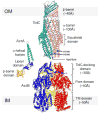Assembly and transport mechanism of tripartite drug efflux systems
- PMID: 19289182
- PMCID: PMC2671569
- DOI: 10.1016/j.bbapap.2009.02.017
Assembly and transport mechanism of tripartite drug efflux systems
Abstract
Multidrug efflux (MDR) pumps remove a variety of compounds from the cell into the external environment. There are five different classes of MDR pumps in bacteria, and quite often a single bacterial species expresses multiple classes of pumps. Although under normal circumstances MDR pumps confer low-level intrinsic resistance to drugs, the presence of drugs and mutations in regulatory genes lead to high level expression of MDR pumps that can pose problems with therapeutic treatments. This review focuses on the resistance nodulation cell division (RND)-class of MDR pumps that assemble from three proteins. Significant recent advancement in structural aspects of the three pump components has shed new light on the mechanism by which the tripartite efflux pumps extrude drugs. This new information will be critical in developing inhibitors against MDR pumps to improve the potency of prescribed drugs.
Figures



References
-
- Poole K. Bacterial multidrug efflux pumps serve other functions. Microbe. 2008;3:179–185.
Publication types
MeSH terms
Substances
Grants and funding
LinkOut - more resources
Full Text Sources
Other Literature Sources

